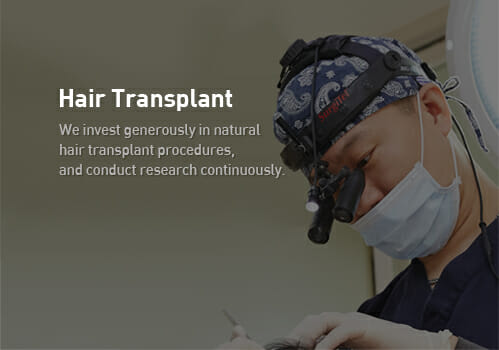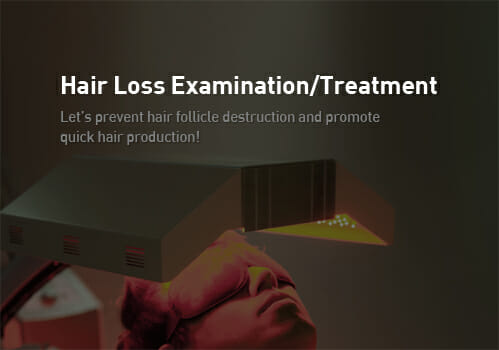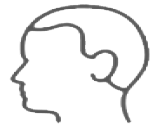Combination Hair Loss Treatment Program
Suitable for Hair Loss Patients According to Type
Hair Loss Treatment According to Type
It inhibits factors responsible for the destruction of hair follicles,
and regulates the cycle of hair follicle growth to
promote hair growth among hereditary hair loss patients.
Hair Loss Treatment / Examination
The duration of hair loss treatment can be determined once you observe that “I am losing my hair!”
Although early treatment is important to hair loss, just like when dealing with other diseases, people usually ignore the symptoms and miss the optimal timing of treatment.
The majority of patients rely on folk remedies, including shampoos that are advertised as having ingredients that can prevent hair loss, and unproven hair loss treatment,
rather than looking at what specialized institutions can offer.
Even if you experienced effective hair treatment for a while, it is difficult to stop hair loss completely through such means.
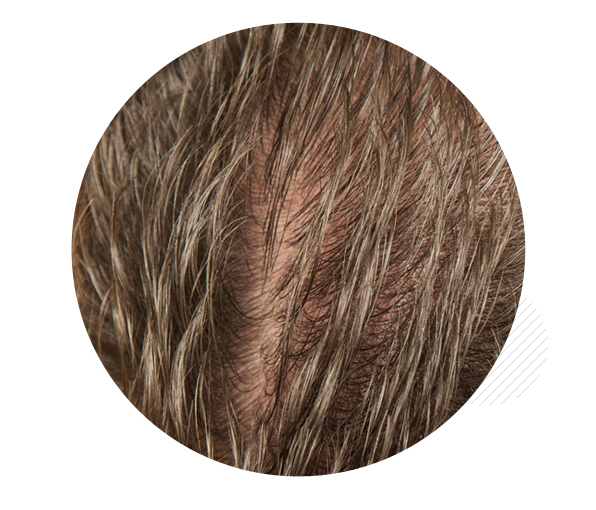
The key to early hair loss prevention is keeping hair follicles alive.
In order for hair to grow, hair follicles must be in good condition, so the hair follicles must be checked first, other than the duration of hair loss. The condition of the hair
follicles can be checked through New Hair’s three-step hair loss examination (hair volume check, hair pull test, and folliscopy). A meticulous assessment of the progression of
hair loss is vital in predicting the 'speed' and the 'degree' of future hair loss. Remember that hair loss is a disease that you should not ignore and, once detected, you must
try to secure appropriate counseling and treatment.
Self-diagnosis (hair volume check)
It is a means of comparing the hair on the back with the hair on the other parts of the head.
See if your forehead has become wider, or if your hairline has changed into a U-shape.
Check if you are losing more than 100 strands of hair per day, or if your hair became thinner and weaker.
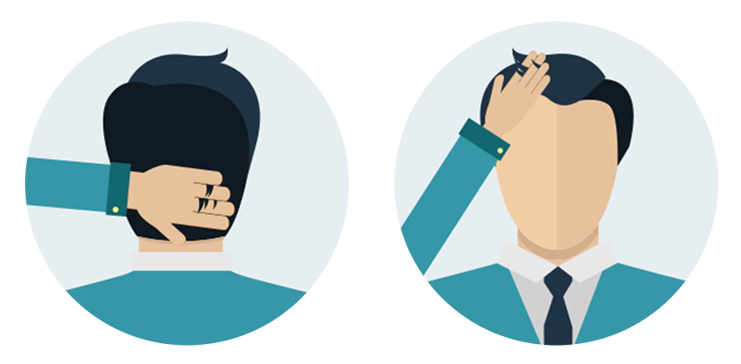
CHECK POINT
CHECK POINT Gently rub the hair on the top of the head and at the back side with two fingers, the thumb and the index finger. (If you feel that the hair on the top of the head gradually becomes thinner when checking the same area, you may be experiencing hair loss.)
-
 Alopecia Areata Treatment.
Alopecia Areata Treatment. -
 Alopecia Areata Treatment.
Alopecia Areata Treatment. -
 Postpartum Hair Loss
Postpartum Hair Loss -
 Treatment Hair Loss Treatment for Office Workers
Treatment Hair Loss Treatment for Office Workers -
 Hair Loss Treatment after Hair Transplant Surgery
Hair Loss Treatment after Hair Transplant Surgery
Alopecia Areata Treatment
Alopecia areata is most likely to recur. It is too early to relax!
Alopecia areata is a hair loss condition that does not happen only once, even if it involves someone who has never experienced it.
In alopecia areata, hair is lost in the shape of a coin-sized circle on one side of the head.
Although the apparent cause is not yet known, genetic causes, environmental factors, or autoimmune responses, in which the body starts attacking itself, are contributing factors.
It is known that alopecia areata commonly occurs when one is under severe stress.

Compared to other types of hair loss, alopecia areata has a high natural cure rate, though it also has a high risk of recurrence.
Early symptoms include hair falling off in an area that resembles a coin, pores becoming invisible on the scalp, and, if this condition persists, it will spread and it will eventually lead to baldness.
Since alopecia areata is characterized by recurrent symptoms, special attention and precise early treatment are required.
Treatment Method

3 Steps of Hair Loss Examination
Hair volume check/ Hair pull test/ Folliscopy
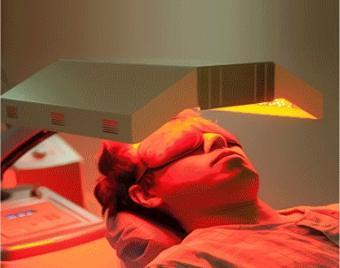
Low-Level Laser Therapy (LLLT)
Enhancing hair growth / Strengthening hair follicles / Increasing hair thickness
Thinning Hair Treatment
Are you stressed by the sight of dull, fine hair, and is it affecting the way you look?
Since it is not easy to look good with fine hair, and fine hair can make people look older, most people yearn to have elastic and thick hair.
There are many reasons why hair is thinning, but it is more common in women experiencing stress, menopause, and hypothyroidism.
Therefore, it is advisable to consult with a specialist before undergoing hair loss treatment.

What is the reason for thinning hair?
Thinning hair, as a whole, is a symptom of diffuse unpatterned alopecia (DUPA) and diffused patterned alopecia (DPA). DPA and DUPA have similar early symptoms, including hair thinning broadly in the bangs, on top of the head, etc., while the front hairline is maintained, though prognosis and treatment responses are different.

DUPA
It is rare in men, but common in women. Since hair loss occurs around the entire scalp, it affects even the hair at the back, which can be used as a hair transplant material, and the volume of hair that can be used in transplants can be reduced. Regarding folliscopy, the density of the hair is reduced, and the volume reduction rate is over 35% on the hair volume check. Since the site of the transplant is also affected, the hair grafts may be thin at the time of the hair transplant. Among DUPA patients, shedding (a symptom of hair falling off) of existing thinning hair may be severe at the site of the hair transplant. In this case, as hair loss progresses over time, the scars at the collection sites may become more visible. People, for whom such symptom is predicted or suspected, are not automatic candidates for hair transplant. Prior to full-scale hair loss treatment for DUPA, hereditary hair loss, anemia, thyroid disease, connective tissue disease, gynecologic causes, and other emotional stress conditions must be suspected first as a cause of hair loss.
Treatment Method

Hair Volume Check
Checking the degree of the decrease in the hair volume and in the area

Folliscopy
Checking the thickness of hair / the thinning range
Postpartum Hair Loss Treatment
If left untreated, it may lead to permanent hair loss!
After giving birth, many women experience temporary hair loss. It usually begins to appear from 2 to 5 months after giving birth, and hair loss tends to occur at 1/3 part of
the front of the head. When a woman becomes pregnant, she experiences general weakness so she can provide nutrients to the fetus, and changes in the endocrine
hormones occur, resulting in hair loss.
Usually, postpartum hair loss lasts for 2-6 months, and recovery can occur without any special treatment. However, if you are stressed after giving birth, or if you cannot
obtain sufficient nutrients, hair loss may become permanent.
If hair loss persists and worsens 6 months after giving birth, it is recommended that you seek medical attention for further examination.

Treatment Method

Low-Level Laser Therapy (LLLT)
Increasing the richness of hair/ Increasing the thickness of hair/ Increasing the density of hair
Hair Loss Treatment for Office Workers
One in two new employees has thought about leaving the company.
According to a study conducted by a survey company, 52.2% of office workers responded that they suffered from physical and mental stress due to recession, and 6.3% among them said they suffered hair loss due to mental stress.

Frequent company dinners, interruptions to the life cycle due to night duties, and lack of exercise
regardless of age and gender can lead to hair loss!
If you think you are suffering from hair loss, we recommend that you visit our office for diagnosis and obtain appropriate care. We will take care of you with customized examination/treatment, which is based on 10 years of know-how after studying the anxieties and troubles of office workers.
Treatment Method

Low-Level Laser Therapy (LLLT)
Increasing the richness of hair/ Increasing the thickness of hair/ Increasing the density of hair

Scalp Scaling
Oxygen supply to hair and scalp / Sebum & keratin removal / Clean scalp maintenance / Waste removal
Hair Loss Treatment after Hair Transplant Surgery
The most common question of patients after hair transplant is, 'Will my hair grow back?'
It is very important to watch the progress of the operation one year after the hair transplant surgery.
Hair follicles are almost settled usually 6 months to 1 year later, and the hair starts growing back. If you avail of hair loss treatment early, you can make your hair look healthier.
After the transplant, you will look at the mirror more often, and you can look forward to your hair growing back.
However, some patients experience stress again due to anxiety or impatience, and hair may start falling even after undergoing hair transplant.
In this case, even if the transplant is successful, it is difficult to achieve satisfactory results, so it is better to concentrate on care while controlling the mind and the body.
Through constant care, we can help you get your hair engrafted faster and more stably.

Can I stop taking the drug (Propecia) after I undergo hair transplant?
Even after a hair transplant, it should be carefully considered whether or not you will discontinue medication, such as Finasteride (Propecia), Dutasteride (Avodart), and Minoxidil (Rogaine).
Most people get hair transplant without taking medication. However, if you do not take Propecia before surgery, you will likely experience shedding.
Furthermore, you must keep in mind that hair loss will continue, and you might need additional hair transplant after a few years if you do not obtain hair loss treatment after undergoing hair transplant.
Treatment Method

Injection Therapy
Hair follicle production / Nutrition supply / DHT inhibition / Blood circulation improvement

Low-Level Laser Therapy (LLLT)
Increasing the richness of hair/ Increasing the thickness of hair/ Increasing the density of hair
-
 Alopecia Areata Treatment.
Alopecia Areata Treatment. -
 Alopecia Areata Treatment.
Alopecia Areata Treatment. -
 Postpartum Hair Loss
Postpartum Hair Loss -
 Treatment Hair Loss Treatment for Office Workers
Treatment Hair Loss Treatment for Office Workers -
 Hair Loss Treatment after Hair Transplant Surgery
Hair Loss Treatment after Hair Transplant Surgery
Alopecia Areata Treatment
Alopecia areata is most likely to recur. It is too early to relax!
Alopecia areata is a hair loss condition that does not happen only once, even if it involves someone who has never experienced it.
In alopecia areata, hair is lost in the shape of a coin-sized circle on one side of the head.
Although the apparent cause is not yet known, genetic causes, environmental factors, or autoimmune responses, in which the body starts attacking itself, are contributing factors.
It is known that alopecia areata commonly occurs when one is under severe stress.

Compared to other types of hair loss, alopecia areata has a high natural cure rate, though it also has a high risk of recurrence.
Early symptoms include hair falling off in an area that resembles a coin, pores becoming invisible on the scalp, and, if this condition persists, it will spread and it will eventually lead to baldness.
Since alopecia areata is characterized by recurrent symptoms, special attention and precise early treatment are required.
Treatment Method

3 Steps of Hair Loss Examination
Hair volume check/ Hair pull test/ Folliscopy

Low-Level Laser Therapy (LLLT)
Enhancing hair growth / Strengthening hair follicles / Increasing hair thickness
Thinning Hair Treatment
Are you stressed by the sight of dull, fine hair, and is it affecting the way you look?
Since it is not easy to look good with fine hair, and fine hair can make people look older, most people yearn to have elastic and thick hair.
There are many reasons why hair is thinning, but it is more common in women experiencing stress, menopause, and hypothyroidism.
Therefore, it is advisable to consult with a specialist before undergoing hair loss treatment.

What is the reason for thinning hair?
Thinning hair, as a whole, is a symptom of diffuse unpatterned alopecia (DUPA) and diffused patterned alopecia (DPA). DPA and DUPA have similar early symptoms, including hair thinning broadly in the bangs, on top of the head, etc., while the front hairline is maintained, though prognosis and treatment responses are different.

DUPA
It is rare in men, but common in women. Since hair loss occurs around the entire scalp, it affects even the hair at the back, which can be used as a hair transplant material, and the volume of hair that can be used in transplants can be reduced. Regarding folliscopy, the density of the hair is reduced, and the volume reduction rate is over 35% on the hair volume check. Since the site of the transplant is also affected, the hair grafts may be thin at the time of the hair transplant. Among DUPA patients, shedding (a symptom of hair falling off) of existing thinning hair may be severe at the site of the hair transplant. In this case, as hair loss progresses over time, the scars at the collection sites may become more visible. People, for whom such symptom is predicted or suspected, are not automatic candidates for hair transplant. Prior to full-scale hair loss treatment for DUPA, hereditary hair loss, anemia, thyroid disease, connective tissue disease, gynecologic causes, and other emotional stress conditions must be suspected first as a cause of hair loss.
Treatment Method

Hair Volume Check
Checking the degree of the decrease in the hair volume and in the area

Folliscopy
Checking the thickness of hair / the thinning range
Postpartum Hair Loss Treatment
If left untreated, it may lead to permanent hair loss!
After giving birth, many women experience temporary hair loss. It usually begins to appear from 2 to 5 months after giving birth, and hair loss tends to occur at 1/3 part of
the front of the head. When a woman becomes pregnant, she experiences general weakness so she can provide nutrients to the fetus, and changes in the endocrine
hormones occur, resulting in hair loss.
Usually, postpartum hair loss lasts for 2-6 months, and recovery can occur without any special treatment. However, if you are stressed after giving birth, or if you cannot
obtain sufficient nutrients, hair loss may become permanent.
If hair loss persists and worsens 6 months after giving birth, it is recommended that you seek medical attention for further examination.

Treatment Method

Low-Level Laser Therapy (LLLT)
Increasing the richness of hair/ Increasing the thickness of hair/ Increasing the density of hair
Hair Loss Treatment for Office Workers
One in two new employees has thought about leaving the company.
According to a study conducted by a survey company, 52.2% of office workers responded that they suffered from physical and mental stress due to recession, and 6.3% among them said they suffered hair loss due to mental stress.

Frequent company dinners, interruptions to the life cycle due to night duties, and lack of exercise
regardless of age and gender can lead to hair loss!
If you think you are suffering from hair loss, we recommend that you visit our office for diagnosis and obtain appropriate care. We will take care of you with customized examination/treatment, which is based on 10 years of know-how after studying the anxieties and troubles of office workers.
Treatment Method

Low-Level Laser Therapy (LLLT)
Increasing the richness of hair/ Increasing the thickness of hair/ Increasing the density of hair

Scalp Scaling
Oxygen supply to hair and scalp / Sebum & keratin removal / Clean scalp maintenance / Waste removal
Hair Loss Treatment after Hair Transplant Surgery
The most common question of patients after hair transplant is, 'Will my hair grow back?'
It is very important to watch the progress of the operation one year after the hair transplant surgery.
Hair follicles are almost settled usually 6 months to 1 year later, and the hair starts growing back. If you avail of hair loss treatment early, you can make your hair look healthier.
After the transplant, you will look at the mirror more often, and you can look forward to your hair growing back.
However, some patients experience stress again due to anxiety or impatience, and hair may start falling even after undergoing hair transplant.
In this case, even if the transplant is successful, it is difficult to achieve satisfactory results, so it is better to concentrate on care while controlling the mind and the body.
Through constant care, we can help you get your hair engrafted faster and more stably.

Can I stop taking the drug (Propecia) after I undergo hair transplant?
Even after a hair transplant, it should be carefully considered whether or not you will discontinue medication, such as Finasteride (Propecia), Dutasteride (Avodart), and Minoxidil (Rogaine).
Most people get hair transplant without taking medication. However, if you do not take Propecia before surgery, you will likely experience shedding.
Furthermore, you must keep in mind that hair loss will continue, and you might need additional hair transplant after a few years if you do not obtain hair loss treatment after undergoing hair transplant.
Treatment Method

Injection Therapy
Hair follicle production / Nutrition supply / DHT inhibition / Blood circulation improvement

Low-Level Laser Therapy (LLLT)
Increasing the richness of hair/ Increasing the thickness of hair/ Increasing the density of hair


